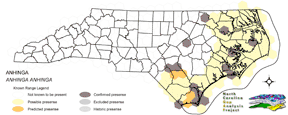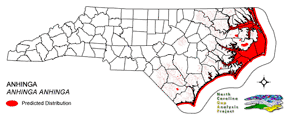
| Taxa: |
| Order: |
| Family: |
| Aves |
| Pelecaniformes |
| Anhingidae |
| NatureServe Global Rank: |
| NatureServe State (NC) Rank: |
| G5 |
| S2B,SZN |
| Federal Status: |
| NC State Status: |
| --- |
| SR |


| Land Unit |
| US Fish & Wildlife Service |
| US Forest Service |
| US National Park Service |
| US Department of Defense |
| NC State Parks |
| NC University System |
| NC Wildlife Res. Com. |
| NC Forest Service |
| NC Div. of Coastal Mgmt. |
| Local Governments |
| Non-Governmental Org. |
| Other Public Lands |
| Private Lands |
| GAP Status 1-2 |
| All Protected Lands |
| Statewide |
| Hectares |
| 8,696.70 |
| 1,401.48 |
| 3,969.36 |
| 1,119.24 |
| 2,407.14 |
| 258.12 |
| 2,366.91 |
| 401.49 |
| 850.95 |
| 25.02 |
| 1,672.29 |
| 37.26 |
| 167,252.67 |
| 15,687.45 |
| 23,232.33 |
| 190,458.63 |
| Acres |
| 21,490.01 |
| 3,463.13 |
| 9,808.50 |
| 2,765.70 |
| 5,948.17 |
| 637.83 |
| 5,848.76 |
| 992.10 |
| 2,102.74 |
| 61.83 |
| 4,132.32 |
| 92.07 |
| 413,290.27 |
| 38,764.53 |
| 57,408.33 |
| 470,633.43 |
| % of Dist. on |
| Prot. Lands |
| 37.4 % |
| 6.0 % |
| 17.1 % |
| 4.8 % |
| 10.4 % |
| 1.1 % |
| 10.2 % |
| 1.7 % |
| 3.7 % |
| 7.2 % |
| 7.2 % |
| 0.1 % |
| 0.2 % |
| 67.5 % |
| ----- |
| ----- |
| % of Dist. on |
| All Lands |
| 4.6 % |
| 0.7 % |
| 2.1 % |
| 0.6 % |
| 1.3 % |
| 0.1 % |
| 1.2 % |
| 0.2 % |
| 0.4 % |
| < 0.1 % |
| 0.9 % |
| < 0.1 % |
| 87.8 % |
| 8.2 % |
| ----- |
| ----- |
|
Uncommon to fairly common and local along the coast (Fussell 1994), especially north to Lake Ellis (Craven County). Rarely seen north to Currituck Sound, and rare inland to Rocky Mount and the Catawba River near Charlotte (Potter et al. 1980). Found in quiet, sheltered, slow-moving bodies of open water such as rivers, cypress swamps, wooded ponds, inlets, lagoons, and lakes, especially with standing snags (Fussell 1994, Kaufman 1996). Nests in pairs or colonies, often in association with herons, ibises, cormorants (Kaufman 1996), and/or egrets (Ehrlich et al. 1988). Builds nest in a tree, from 4 to 20 feet above the ground. Will also usurp a currently occupied heron or egret nest (Ehrlich et al. 1988). Hunts in fresh water by swimming on the surface or under water. Frequently perches in the sun to dry plumage (Kaufman 1996). NATURE SERVE GLOBAL HABITAT COMMENTS: Freshwater swamps, lakes, and sluggish streams at low elevations and, in tropical regions, primarily around brackish lagoons and in mangroves (AOU 1983). In Louisiana, most nesting areas are freshwater, some brackish; mainly cypress swamps, sometimes in freshwater marshes (Portnoy, cited by Johnsgard 1993). Favored habitats have areas of open nonturbid water (Palmer 1962). Nests near top of tree or shrub 1-6 m above water or ground, often near wading birds and cormorants. Male establishes nest site, both sexes build. |
| Code | Name | Description | NC Natural Heritage Program Equivalent |
| 124 | Maritime Scrubs and Tidal Shrublands | Coastal shrubs including wax-myrtle, swamp rose, alder, yaupon, and greenbriar. | Maritime Shrubs, Salt Shrub |
| 75 | Tidal Swamp Forest | Swamp tupelo dominated forest with or without black tupelo and/or cypress trees. Restricted to the tidal zones in the coastal plain. May have inclusions of coastal red cedar woodlands. | Tidal cypress - gum swamp |
| 121 | Maritime Pinelands | Loblolly forests and woodlands of the outer coastal plain. | Estuarine Fringe Loblolly Pine Forest |
| 17 | Maritime Forests and Hammocks | Maritime forests and woodlands dominated by live or sand laurel oak. Estuarine Fringe forests dominated by loblolly pine. | Coastal Fringe Evergreen Forest, Maritime Deciduous Forest, Maritime Deciduous Forest |
| 126 | Interdune Wooded Depression Swamp | Includes swamps dominated by sweetbay and swampbay or dogwood dominated forests. | Maritime Shrub Swamp, Maritime Swamp Forest |
| 173 | Coastal Plain Riverbank Shrubs | Shrub dominated riverbanks, commonly dominated by willows and/or alders. | Sand and Mud Bar |
| 50 | Coastal Plain Mixed Bottomland Forests | Includes forests dominated by a variety of hardwood species, including sweetgum, cottonwood, red maple. | Coastal Plain Bottomland Hardwood (in part), Coastal Plain Levee Forest |
| 49 | Coastal Plain Oak Bottomland Forest | Bottomland forests dominated by deciduous oak alliances. Oaks represented can include swamp chestnut, cherrybark, willow, and/or overcup oak. Inclusions of loblolly pine temporarily flooded forests occur in patches. Hydrology is temporarily to seasonally flooded. | Coastal Plain Bottomland Hardwoods (in part) blackwater subtype, brownwater subtype |
| 158 | Coastal Plain Nonriverine Wet Flat Forests | Loblolly pine - Atlantic white-cedar - red maple - swamp tupelo saturated forests as well as forests dominated by loblolly, sweetgum, and red maple in non-riverine flats. | Non-riverine Wet Hardwood Forest |
| 41 | Peatland Atlantic White-Cedar Forest | Dense stands of Atlantic white cedar with saturated hydrology. Can include swamp tupelo, red maple, and pond pines with a moderate shrub and herb layer. | Peatland Atlantic White-Cedar Forest |
| 15 | Seepage and Streamhead Swamps | Includes extensive peat flats in the coastal plain, dominated by swamp tupelo, maples, and Atlantic white cedar alliances. In the sandhills includes streamhead pond pine and bay forests alliances. Saturated hydrology. | Bay Forest, Small Depression Pocosin, Streamhead Atlantic White Cedar Forest, Streamhead Pocosins |
| 30 | Cypress-Gum Floodplain Forests | Swamps dominated by black or swamp tupelo with or without Taxodium. Seasonally to semi-permanently flooded hydrology. | Cypress-Gum Swamps |
| 78 | Pond-Cypress - Gum Swamps, Savannas and Lakeshores | Cypress dominated swamps and lakeshores. Can include bays dominated by pond cypress or shorelines of coastal plain lakes with a narrow band of cypress. | Non-riverine Swamp Forest, Natural Lakeshores (in part) |
| 385 | Oak Bottomland Forest and Swamp Forest | The swamp chestnut oak, cherrybark oak, shumard oak and sweetgum alliance is one representative. Other alliances are dominated by water, willow, and overcup oaks. Swamp forests can be dominated by sweetgum, red maple, and black gum being dominant. Loblolly can occur in combination with sweetgum and red maple, or with tulip poplar. Includes saturated and semi- to permanently flooded forests in the mountains. | Piedmont/Mountain Bottomland Forest, Piedmont/Mountain Swamp Forest |
| 63 | Coastal Plain Mesic Hardwood Forests | Beech dominated forests with white oak and northern red oak as possible co-dominants. Dry-mesic to mesic forests on slopes and small stream bottoms in the coastal plain. | Mesic Mixed Hardwood Forest, Basic Mesic Forests |
| 138 | Coastal Plain Dry to Dry-Mesic Oak Forests | Oak dominated forests of the coastal plain. Includes white oak forests with water oak or northern red oak and hickories as co-dominants. | Dry Mesic Oak Hickory Forest, Basic Oak Hickory Forest, Dry Oak Hickory Forest |
| 267 | Riverbank Shrublands | Riverside shrubs with temporarily flooded hydrologies. Found in the both the Mountains and Piedmont. Containing dominants such as smooth alder and a Carolina or black willows. | Sand and Mud Bar |
| 269 | Floodplain Wet Shrublands | Saturated shrublands of the Piedmont, includes buttonbush, swamp-loosestrife, decodon and alders. | Piedmont/mountain Semipermanent Impoundment |
| 230 | Piedmont Mesic Forest | American Beech - Red Oak - White Oak Forests. | Mesic Mixed Hardwood |
| 384 | Piedmont/Mountain Mixed Bottomland Hardwood Forests | Includes temporarily to seasonally forests dominated by hardwood species. Hardwoods include sweetgum, red maple, sycamore which co-occur in a mosaic of bottomland and levee positions. Includes alluvial hardwood forests in the mountains. Hemlock and white pine may occur as inclusions, but are generally mapped separately. | Piedmont/Mountain Alluvial Forest, Piedmont/Mountain Levee Forest |
| 8 | Open water | Open water without aquatic vegetation. | No equivalent |
|
Johnsgard, P. A. 1993. Cormorants, darters, and pelicans of the world. Smithsonian Inst. Press, Washington, D.C. xiv + 445 pp.
Fussell, J.O. III. 1994. A birderís guide to coastal North Carolina. Chapel Hill and London: The University of North Carolina Press. Kaufman K. 1996. Lives of North American Birds. Boston, New York: Houghton Mifflin Company. Palmer, R. S. (editor). 1962. Handbook of North American birds. Vol. 1. Loons through flamingos. Yale University Press, New Haven. 567 pp. Harrison, H.H. 1979. A field guide to western birds' nests. Houghton Mifflin Company, Boston. 279 pp. Potter, E. F., J. F. Parnell, and R. P. Teulings. 1980. Birds of the Carolinas. Univ. North Carolina Press, Chapel Hill. 408 pp. Terres, J.K. 1980. The Audubon Society encyclopedia of North American birds. Alfred A. Knopf, New York. American Ornithologists' Union (AOU), Committee on Classification and Nomenclature. 1983. Check-list of North American Birds. Sixth Edition. American Ornithologists' Union, Allen Press, Inc., Lawrence, Kansas. Ehrlich, P.R., D.S. Dobkin, and D. Wheye. 1988. The birder's handbook:a field guide to the natural history of North American birds. Simon and Shuster, Inc., New York. xxx + 785 pp. Root, T. 1988. Atlas of wintering North American birds:An analysis of Christmas Bird Count data. University of Chicago Press. 336 pp. Spendelow, J.A., and S.R. Patton. 1988. National atlas of coastal waterbird colonies in the contiguous United States:1976-1982. U.S. Fish and Wildlife Service, Biological Report 88(5). x + 326 pp. |
For more information please contact them at:
NC-GAP Analysis Project
Dept. of Zoology, NCSU
Campus Box 7617
Raleigh, NC 27695-7617
(919) 513-2853
www.basic.ncsu.edu/ncgap